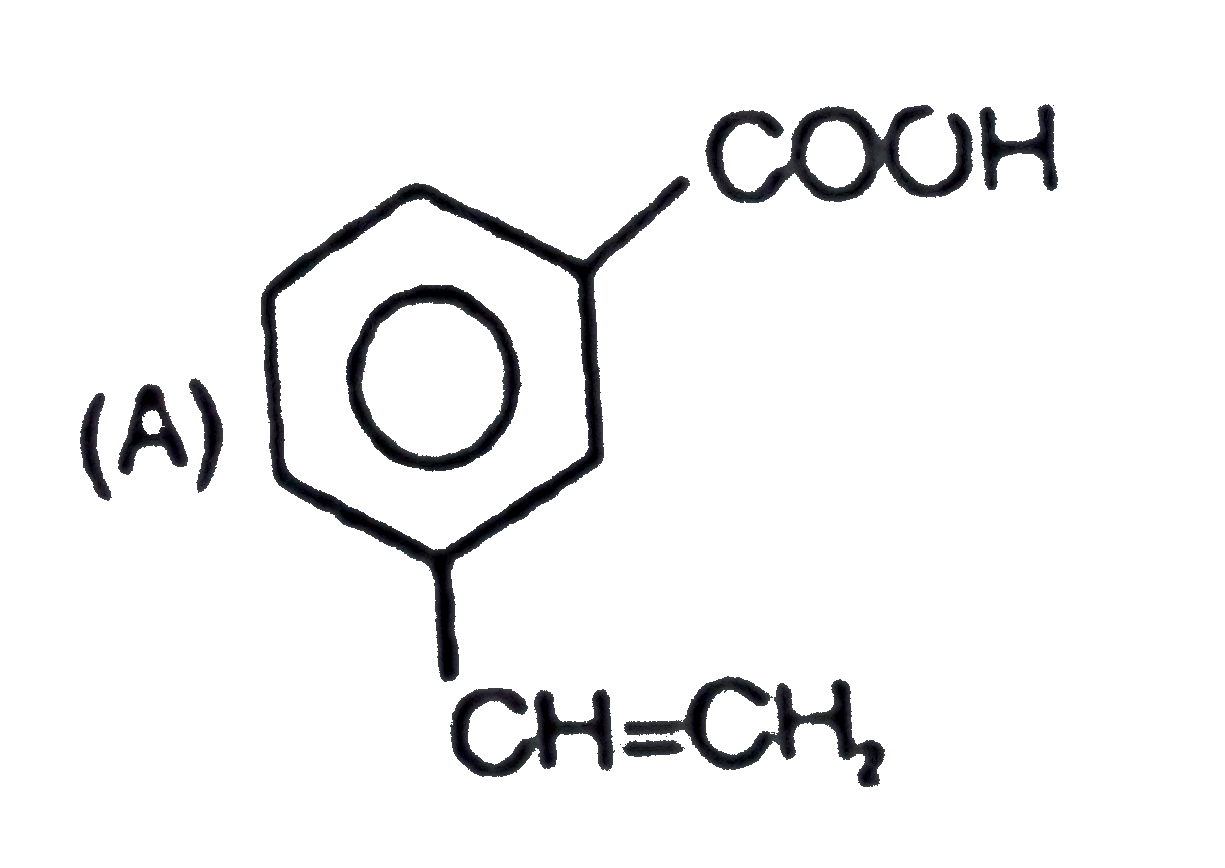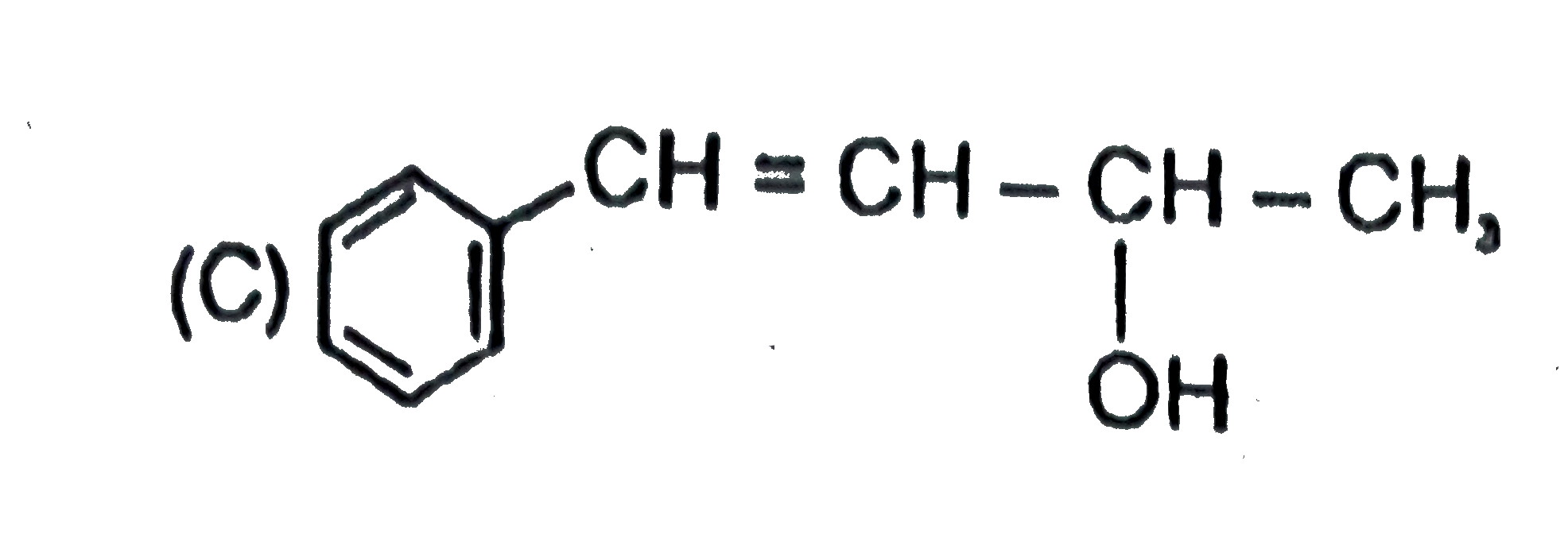Compound 'P' (C10H12O) evolves H2 gas with Na metal.It reacts with Br2/CCl4 to give 'Q' (C10H12Br2O).With I2/NaOH it forms iodoform and an acid 'R' (C9H8O2) .'P' has geometrical and optical isomers. The struture of 'P' and 'R' should be

PH-CH=CH-COOH


The correct Answer is:B,C
To solve the problem, we need to identify the structures of compounds P and R based on the information provided. Let's break down the information step by step.
Step 1: Analyze the information about compound P
1. Molecular formula: Compound P has the formula C10H12O.
2. Reaction with Na metal: It evolves hydrogen gas, indicating the presence of an alcohol functional group (–OH).
3. Reaction with Br2/CCl4: This suggests that P likely contains a double bond (alkene) that can undergo electrophilic addition.
4. Presence of isomers: P has geometrical (cis/trans) and optical isomers, indicating that it has a chiral center and/or a double bond that can exhibit cis/trans isomerism.
Step 2: Propose a structure for compound P
Based on the above information, we can propose a structure for P. A suitable candidate is:
- Structure of P:
- A phenolic compound with a double bond and an alcohol group.
- One possible structure is:
C6H5C(CH3)=CHCH2OH
This structure has:
- A benzene ring (C6H5)
- A double bond (C=CH)
- An alcohol group (–OH)
Step 3: Analyze the reaction of compound P to form compound Q
1. Reaction with Br2/CCl4: The double bond in compound P will react with bromine to form compound Q, which will have two bromine atoms added across the double bond.
2. Structure of Q:
- The addition of bromine will yield:
C6H5C(Br)=C(Br)CH2OH
Step 4: Analyze the reaction of compound P with I2/NaOH
1. Iodoform reaction: The presence of a methyl group adjacent to the alcohol indicates that P can undergo the iodoform reaction, leading to the formation of iodoform (CHI3) and an acid.
2. Formation of compound R:
- The iodoform reaction will oxidize the alcohol to a carboxylic acid.
- The resulting acid R will have the structure:
C6H5C(CH3)=C(COOH)
Step 5: Final structures
- Compound P:
C6H5C(CH3)=CHCH2OH
- Compound R:
C6H5C(CH3)=C(COOH)
Summary
- The structure of compound P is a phenolic compound with a double bond and an alcohol group.
- The structure of compound R is the corresponding carboxylic acid formed after the iodoform reaction.
1. Molecular formula: Compound P has the formula C10H12O.
2. Reaction with Na metal: It evolves hydrogen gas, indicating the presence of an alcohol functional group (–OH).
3. Reaction with Br2/CCl4: This suggests that P likely contains a double bond (alkene) that can undergo electrophilic addition.
4. Presence of isomers: P has geometrical (cis/trans) and optical isomers, indicating that it has a chiral center and/or a double bond that can exhibit cis/trans isomerism.
Based on the above information, we can propose a structure for P. A suitable candidate is:
- Structure of P:
- A phenolic compound with a double bond and an alcohol group.
- One possible structure is:
C6H5C(CH3)=CHCH2OH
This structure has:
- A benzene ring (C6H5)
- A double bond (C=CH)
- An alcohol group (–OH)
1. Reaction with Br2/CCl4: The double bond in compound P will react with bromine to form compound Q, which will have two bromine atoms added across the double bond.
2. Structure of Q:
- The addition of bromine will yield:
C6H5C(Br)=C(Br)CH2OH
1. Iodoform reaction: The presence of a methyl group adjacent to the alcohol indicates that P can undergo the iodoform reaction, leading to the formation of iodoform (CHI3) and an acid.
2. Formation of compound R:
- The iodoform reaction will oxidize the alcohol to a carboxylic acid.
- The resulting acid R will have the structure:
C6H5C(CH3)=C(COOH)
- Compound P:
C6H5C(CH3)=CHCH2OH
- Compound R:
C6H5C(CH3)=C(COOH)
- The structure of compound P is a phenolic compound with a double bond and an alcohol group.
- The structure of compound R is the corresponding carboxylic acid formed after the iodoform reaction.
Topper's Solved these Questions
Similar Questions
Compound (X ) C7H8O dissolves in NaOH but not in NaHCO3 ( X) reacts rapidly with Br2 to give (Y) C7H5OBr3 Product structure of X would be
View SolutionCompound (A)C7H8O is insoluble in aqueous NaHCO3 and dissolves in aqueous NaOH and gives a characteristic colour with neutral FeCl3 . When treated with Br2(A) forms compound (B)C7H5OBr3.
The most probable structure of compound A is :
View Solution
Knowledge Check
An alcohol of formula C9H12O reacts with Na2Cr2O7 to form a compound having formula C9H10O. The original alcohol might be
A B
B C
C D
D
Compound X C4H8O which gives 2,4-DNP derivative and negative iodoform test is
A B
B C
C D
D
Compound X C4H8O which gives 2,4-DNP derivative and negative iodoform test is
A B
B C
C D
D
How many isomers of C4H10O reacts with Na metal to evolve H2 gas ? (excluding stereoisomer)
View SolutionHow many coulomb are required for the oxidation of 1 mol of H2O2→O2?
View SolutionC7H10O reacts with CH3MgBr r to give a compound C8H10O which gives the test with iodoform, than fine out structure of A
View SolutionCompounds P(C6H10) does not have any geometrical isomer.On ozonolysis, two products R(C3H4O) and Q(C3H6O) are formed.R gives negative iodoform test while Q responds positively towards I2/NaOH solution.S, another isomer of P is an unsymetrical alkene and on ozonolysis produces T(C6H107) which also gives a yellow precipitate with l2/NaOH solution and also positive test with Tollen's reagent Which of the following does not represent any of the molecules amongst P,Q,R,S & T.
View SolutionAn organic compound (A) (C5H7OCl) reacts rapidly with ethanol to give (B) (C7H12O2). (A) also reacts with water to produce an acid which reacts with bromine to give (C ) (C5H8Br2O2). (B) on boiling with H2SO4 forms an acid (D). When (D) is oxidised with KMnO4 an acid (E ) (C4H6O3) is produced. On mild heating, (E ) gives (F) (C3H6O) which cannot be oxidised by ammoniacal AgNO3. Identify the compounds (A) to (F).
View Solution

